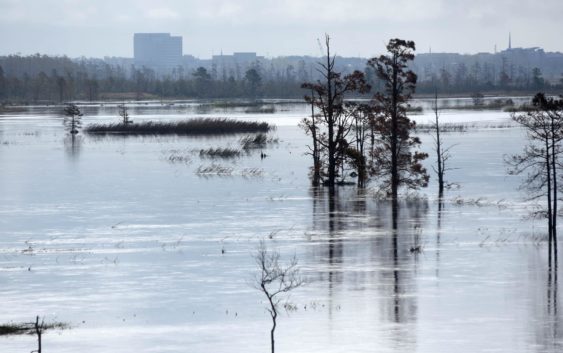- As city leaders consider expanding at-risk zone for wildfire damage, home builders say it could raise costs
- Is your neighborhood at high wildfire risk? | Here's how to check the city's wildfire risk map
- 'Be prepared now': Brad Panovich updates severe weather risk for Sunday
- 'Be prepared now': Brad Panovich updates severe weather risk for Sunday
- As anxiety around wildfires grows, Austin plans to add tens of thousands of acres to risk map
Over Flo: Florence caused slew of sewage spills

The storm and its ensuing floodwaters caused a litany of problems for utilities
SOUTHEASTERN N.C. — More than 23 million gallons of sewage spilled in recent weeks in Brunswick and New Hanover counties have been attributed to flooding, power outages and other conditions caused by Hurricane Florence.
“Some of them were areas that were just completely inundated, and they were conditions that the systems were never designed for. Some of them were loss of power,” said Jim Flechtner, the executive director for Cape Fear Public Utility Authority (CFPUA), which reported 13 spills resulting from Florence.
N.C. Department of Environmental Quality (DEQ) staff are reviewing each reported spill to determine how much sewage was actually spilled and if the facility could have done anything differently to avoid sending sewage into public waterways, said Michael Regan, DEQ’s secretary.
“If they have done anything that has contributed to the exacerbation of exposure to pollution, we will hold them accountable,” he said. “If they have found themselves in a situation that this is purely an act of nature that is unavoidable, then we’re going to begin to engage with them in conversations about what we need to do to strengthen those facilities.”
Regan is also urging utilities in vulnerable areas to consider updated climate science in their rebuilding efforts, taking into account research that shows storms are likely to cause more significant flooding as the planet warms.
“We cannot invest the taxpayer dollars into quick fixes that don’t take into account how we can be more resilient moving forward,” Regan said.
Spills and their impact
Across the area, spills occurred for a wide variety of reasons, with flooding at pump stations and other facilities described as the reason for 18 spills in the region, generator and power issues causing four more spills and other factors causing six other spills — including a CFPUA spill of 10,500 gallons in the 1400 block of Market Street where the sewer main collapsed.
Three other spills do not have stated causes beyond Hurricane Florence, including a Carolina Beach spill that was far and away the region’s largest, sending 17.17 million gallons of wastewater into the Cape Fear River from Sept. 13 and Sept. 17. Carolina Beach town and utility officials did not respond to multiple requests for comment.
Lee Ferguson, a Duke University environmental engineering professor, said sewage spill during a storm such as Florence could result in bacteria that is risky to humans washing into popular recreational areas.
“There might be (sanitary sewer overflows) into marine systems that then become a swimmer hazard — a contact hazard — and you can have people that can get sick from pathogens that are present,” Ferguson said, adding a spill upstream of a drinking water plant means downstream customers are relying on that plant to protect their water.
Since the storm, DEQ has cleared most local beaches and sounds for swimming except the areas around Bald Head Island, which have not been tested because they remain inaccessible.
Ferguson also said the popular idea that floodwaters mean greater dilution of pollutants such as sewage is likely not applicable considering the agricultural waste, septic tanks and other contaminants that were likely washed up into the stream.
“You can’t just take for granted that the floodwater itself is going to be clean because it’s a large volume of water,” Ferguson said. “That larger volume of water is going to be in contact with some significant sources of pollution.”
Local utilities
In Leland, Town Manager David Hollis said utility staff had made all the generators at pump stations were full and been tested. Then staff checked the generators again after the storm knocked power out to guarantee they were running.
From Friday until Sunday, Leland staff ran two of the pump stations by hand.
“Our utilities guys were doing it, our utilities supervisors were doing it, the town engineer was doing it, we had firefighters that volunteered to do it,” Hollis said. “We had a crew lined up to prevent any spills from them, and we’re doing it by hand.”
Despite those efforts, Leland had 10,500 gallons of sanitary sewer overflows during the storm, each caused by flooding. Then, once the power was restored, a bypass pump did not switch on, causing an additional 8,000 gallon spill.
“There’s a lot of public perception about a spill. We try to avoid any negativity like that. We’re trying to protect the environment the best we can,” Hollis said, “so we went to a lot of effort to try to do what we could to keep from having a spill of any kind.”
CFPUA’s largest spill also occurred, Flechtner said, despite significant preparation. At the utility’s Southside treatment plant on River Road, 5.25 million gallons spilled into the Cape Fear River on Sept. 14 when a backup generator failed.
Utility staff had tested the generator four hours before the storm’s arrival, making sure it ran properly. As soon as power went out and the generator went on, though, a voltage regulator failed, causing the spill.
“The question is, when events come up, are you prepared to deal them? And do you have the resources to deal with them?” Flechtner said. “And we do, but this was an extreme event.”
Reporter Adam Wagner can be reached at Adam.Wagner@GateHouseMedai.com.